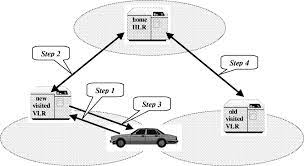

Register the SIM
image ©researchgate
Mobile roaming
image ©Daisy CommunicationsWhen a customer walks out of a shop with a new phone and new SIM, the shop staff will have registered the SIM on their HLR / HSS of their network. This defines the home network. They will also add the equipment number (IMEI) to the equipment register to indicate that the device is a valid device
Everytime a MS with a SIM is switched on, it has to be registered on the network. The MS will search for the strongest HOME network signal. Assuming that one is found; the MS is registered on that network using the IMSI. This registration will :
- Check that the equipment is not blacklisted EIR
- Set up authentication which is carried out using public - private key authentication
- Add the IMSI and other details to the VLR connected to the MSC managing the SIM on that area of the network
When a phone is roaming, not within the home country the process is similar but the phone will not find a HOME network. It will search for the strongest signal. Once found it will ask if it can join that network. The roaming network will then have to negotiate with the home network to check if the SIM can be registered on the roaming network. If this is rejected, then the MS will search for another network. When a roaming network is agreed with the home network a TIMSI (Temporary IMSI) will be allocated to the SIM and this will be used on the roaming network. management of the MS / SIM. Settings on a phone can give priority to some networks whilst roaming.
There is no technical reason why with the home country, roaming could be allowed. Thus for example a Vodafone SIM could be allowed to roam onto a O2 network. The only reason is that the home network will not allow this. However allowing roaming in the home country would be one solution to the problem that in remote areas where one network does not get signal but another does.
© mobilephonetechnology.co.uk all rights reserved 2017-2025
